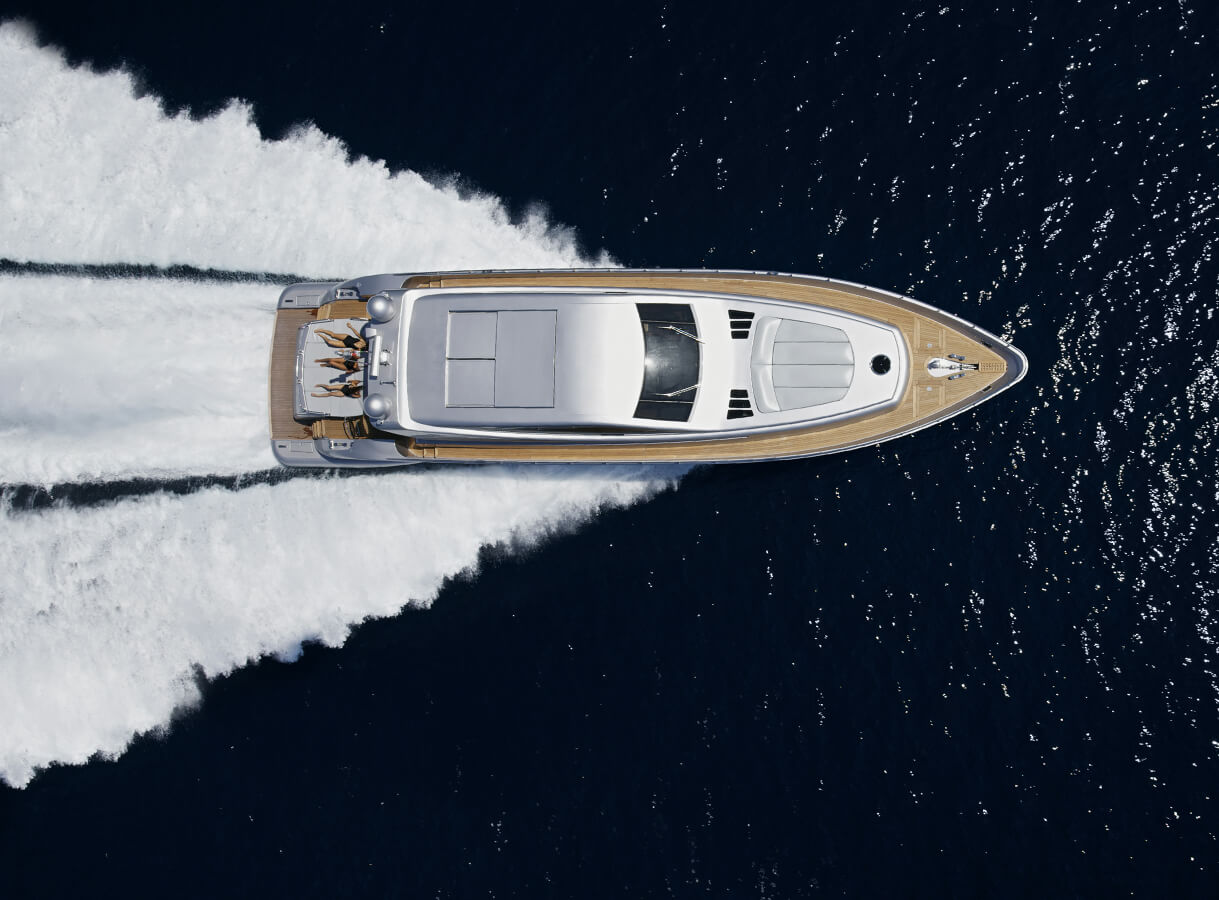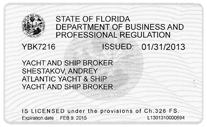Motor Yachts for Sale | Motor Yachts
Various Types of Motor Yachts Revealed - The distinguishing factor between motor and sailing yachts is the fact that motor yachts are powered by a motor exclusively. Among the motor vessel family exists the true “monsters” reaching more than 100 meters in length that nicely coexist with the smaller craft, such as light tenders from 3-4 meters in length. Based on the enormity of the selection, the task of making your choice is often difficult. With this in mind, we are hopeful that describing each type will prove to be educational and helpful to you, the potential buyer.
Within each classification lies a main, significant parameter, setting the standard for each particular class. The amount of motor yacht types is, in fact, synonymous to those belonging to the sailing family. In the majority, they all coincide with sail yacht gradation, excluding the sailing rig specifications. We’ll start with the basic one:
The Hull of a Motor Yacht - The hull is the main part of the vessel. The performance of the yacht depends in large on its shape, material, and construction type. There are several types of classifications, as follows:
-
Classification by Material:
- Wood – Wood is the classic material for building watercrafts. In motor yacht construction, wood is seldom used alone, but most often in combination with metal, fiberglass, etc. Sometimes, the presence of wood is used only in the detailing.
- Plastic – The use of glass or carbon plastic is also used in hull construction. New and improved materials constantly emerge on the market; among them are composite components based on plastic. For starters, it is a very light material, incapable of corroding or rotting, considerably extending the life of the yacht. Its only shortcoming is that it is also very brittle, making it unlikely suitable for arctic waters.
- Metal - As a rule, in the hull construction process also includes such components as steel and aluminum. Steel is susceptible to corrosion and needs continuous care, though simultaneously possessing incredible strength. Yachts built to endure extreme cold conditions, like arctic waters, take advantage of this hull material. Aluminum is the lighter of the two metals, is noncorrosive, but is very soft. On the other hand, it is very simple to repair.
- Ferro Cement - This is a very strong material, unsusceptible to the aggressive effects of salt water.
- Mixed Materials - Yachts may be constructed from a combination of plastic, steel and wood. Usually one material is the foundation, while the others are used as supplements.
-
By Number of Hulls:
- Single-Hull Yacht - A yacht with one or more decks and below deck areas.
- Catamaran – A yacht with connected hulls, a superstructure, and living area under the deck level.
- Trimaran – A yacht with three hulls, one of which is the main equipped with a sleeping area, and the other two auxiliary.
Note: Motor catamarans and trimarans are scarcely seen. More often, motors are used on typical single-hull yachts.
-
By Hull Construction:
- Planing Motor Yachts - During forward motion, the bow of the yacht is raised above the water, and the vessel glides smoothly on the water surface. This is most often seen in racing yachts and tenders.
- Displacement Motor Yachts – The hull stays in the water making the vessel highly stable, but speed potential is limited as seen in cruiser-type vessels.
- Semi-Displacement Motor Yachts - This hull type combines the features of the other two types of hulls and is seen in recreational day-cruisers.
Note: Depending on the ballast distribution design, motor yachts, as well as sailing yachts, are divided into keelboats, center-boarders, bilge-boarders and sliding keel types.
-
Function and Safety Class - Since the safety category is directly related to the functional purpose of the yacht, we will present both of the classifications within the same paragraph. There are four safety classes of motor yachts, as follows:
- Oceanic Vessels - These are large yachts (mega yachts), designed for long-range cruises, and capable of withstanding storms from Level 8 and waves more than 4 meters. The deck of this yacht is equipped with everything essential for autonomous living, and sufficient for crew to live comfortably and safely for months.
- Sea Vessels - These yachts are capable of crossing the sea, but not safe enough to cross either the Atlantic or the Pacific oceans. The primary reason is their size and construction features; they can only challenge winds of up to Level 8, and waves not exceeding 4 meters in height.
- Coastal Yachts – These yachts are typically used near the shore, as they are only capable of withstanding waves up to 2 meters in height and winds no stronger than 6 points on the force scale. Such vessels can be taken out for a cruise along the shoreline. This class also includes race
- Protected Water Yachts - These are the smaller boats not designed for the open seas and incapable of withstanding storms stronger than 4 points, nor waves higher than 0.5 meters. The sizes of yachts in this class begin with boats 2-3 meters in length, and continue upward to the size of a house boat, equipped with an engine, 10-20 meters in length. Much depends on the construction design.
-
Classification of Motor Yachts by Function
- Cruise Yachts – These yachts have large hulls, relatively low speeds, and are suitable for life and pleasure. Among them we can destinguish:
- Megayachts - large ships with luxurious interiors, spacious living accommodations, etc.
- Heavy Cruisers/Expedition Vessels - designed for long-distance voyages.
- Day Cruisers - yachts for short trips, limited accommodations and food storage.
- Race Cruisers - combining all the assets and advantages of both the racing yacht and cruiser, capable of reaching high speeds and equipped for fairly long-distance voyages.
- Racing Yachts - usually planing yachts, lightweight hulls made of aluminum or plastic, powerful engines, not intended for multiple-day’s operation. Among them are: open sea yachts, coastal racing yachts.
Additional Propulsion and Construction features: As mentioned above, the main feature that separates the motor yacht from the sailing yacht is the system that brings the yacht into motion. In the case of the motor yacht, its driving system is its engine, complete with propellers. Beside propellers, there may be other systems used, but they are very rare. This is why yachts are also classified by engine type: gasoline and diesel engines. Diesel engines are typically placed on larger boats. Racing types and tenders are usually equipped with gasoline engines. Other systems that can be used are hybrid or electric power units, which are also rare.
Note: Motor Yachts are also distinguished by their affiliation with a specific classification society.
-
Official Classification - A “classification society” is an organization that regulates the technical standards of yacht design and construction. Each society has its own maritime rules, regulations and requirements. A yacht’s acceptance into a particular society means that the vessel has met and upheld all standards of the society it is affiliated with. These classification societies are, as follows:
- ABS - American Bureau of Shipping
- BV- Bureau Veritas
- CCS - China Classification Society
- DNV - Det Norske Veritas (Norway)
- GL - Germanischer Lloyd (Germany)
- KR - Korean Register of Shipping
- IRS - Indian Register of Shipping
- LR - Lloyd's Register (London)
- NK - Nippon Kaiji Kyokai (Tokyo)
- RINA - Registro Internacional Naval (Lisbon)
- RS - Russian Maritime Register of Shipping
“We have described herein only a sampling of the primary classifications of the motor yacht, in hopes that outlining the featured categories will be beneficial in helping you, the buyer, define your own criteria and, with my help, allow you to choose the perfect yacht”
Andrey Shestakov
Motor Yachts
There are two main types of yachts; those powered by wind which are known as sailing yachts and motor powered yachts. Unless you are a sailor or plan to hire one, and are looking to purchase a yacht, you will likely be looking for “motor yachts for sale” versus sailing yachts.
When it comes to motor powered yachts, there are different types of motors and many other factors involved in choosing the right motor powered, luxury yacht to fit your needs. Atlantic Yacht and Ship, Inc., has an inventory of over 2,000 new and previously owned motor yachts for sale including these brands: Lurssen, Dunya, Mondo Marine, Oceanco, Sunrise, vsy, Abeking & Rasmussen, Baglietto, Trinity, and Benetti.
Working with Atlantic Yacht and Ship, Inc., is advantageous to yacht enthusiasts because we have over 50 years of experience as yacht brokers and are connected with the largest yacht manufacturers throughout the world. We will assist you with the negotiation and closing of your purchase and will even provide insurance, legal and financing services.
Whether you are looking for motor yachts for sale or to sell your yacht, we will help you make the best choice.
-
moreVICTORIOUS 278' 11" AK YACHT 2021 €120,000,000 EUR
-
moreCasino Royale 236' 3" TANKOA YACHTS 2018 €69,000,000 EUR
-
moreTALISMAN C 231' 8" PROTEKSAN-TURQUOISE 2011 €55,000,000 EUR
-
moreWAYFINDER 223' 10" ASTILLEROS ARMON 2021 €55,000,000 EUR
-
morePolar Star 213' 10" LURSSEN 2005 €54,000,000 EUR
-
moreBELLA VITA 196' 11" LURSSEN 2010 $57,500,000 USD
-
moreHEESEN 50M ALUMINIUM YN 21150 PROJECT SOPHIA 164' HEESEN YACHTS 2024 €45,800,000 EUR
-
moreM/Y ANJELIF 50M / 2024 HYBRID 163' 9" COLUMBUS YACHTS 2024 €45,000,000 EUR
-
moreUTOPIA IV 206' 9" ROSSI NAVI 2018 $47,900,000 USD
-
moreProject Secret 169' TANKOA YACHTS 2025 €38,500,000 EUR
-
moreAdmiral 55 S-Force Silver Star 181' 6" ADMIRAL YACHTS 2023 €35,000,000 EUR
-
moreATLANTIQUE 47 154' 3" COLUMBUS YACHTS 2026 €32,500,000 EUR
-
moreDynamiq Global 550 182' 9" DYNAMIQ 2026 €32,500,000 EUR
-
moreKATINA 197' BRODOSPLIT CROATIA 2015 €32,000,000 EUR
-
moreN1 163' 11" OVERMARINE GROUP 2022 €32,000,000 EUR
-
moreDynamiq GTT 170 164' 1" DYNAMIQ 2026 €31,500,000 EUR
-
moreDynamiq Global 500 Hybrid 164' 1" DYNAMIQ 2026 €30,900,000 EUR
-
moreLove For BOA 163' 9" BOA YACHTS 2025 €29,900,000 EUR
-
moreDynamiq GTT 165 164' 1" DYNAMIQ 2026 €29,500,000 EUR
-
moreDynamiq Global 450 149' 4" DYNAMIQ 2026 €28,750,000 EUR
-
moreSEAGULL MRD 163' 9" BENETTI 2020 €27,900,000 EUR
-
moreISA GT 45 145' 5" ISA YACHTS 2026 €26,900,000 EUR
-
moreADA 50Z 163' 9" ADA YACHT WORKS 2025 €26,500,000 EUR
-
moreQUEEN MARE 190' CUSTOM 2012 €24,500,000 EUR
-
moreNEVER SAY NEVER AGAIN 121' 1" BENETTI 2022 €23,995,000 EUR
-
more2026 Inace Aventura 164 164' INACE 2026 $27,094,000 USD
-
moreKIRIBATI38 130' CERRI CANTIERI NAVALI 2025 €23,000,000 EUR
-
moreHALARA (Name Reserved) 141' OVERMARINE GROUP 2021 €22,900,000 EUR
-
moreNORTHERN ESCAPE 133' 11" BENETTI 2022 €22,500,000 EUR
-
moreOTTAWA V 150' 9" BOA YACHTS 2024 €21,900,000 EUR
































































